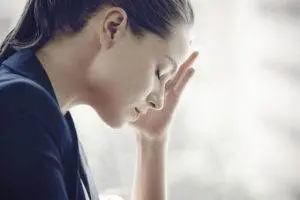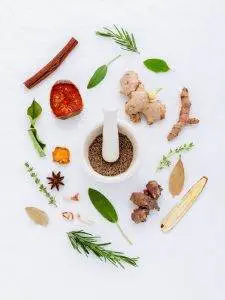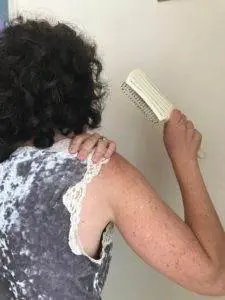
Shoulder pain, which may arise from repetitive movements, sports injuries, or slow degeneration of tissues over time, is one of the most common types of musculoskeletal pain. Most pain in the shoulder is related to the soft tissues of the joints, primarily the rotator cuff tendons and muscles. In most cases doctors recommend medications to reduce pain and inflammation, modifications to normal activity, and take a “wait and see” approach. Serious conditions of frozen shoulder (adhesive capsulitis), torn rotator cuff, or chronic tendonitis in shoulder can be disabling. That is why shoulder pain is one of the complaints most often referred to physical therapy (PT) specialists.
Severe cases of shoulder impingement, collarbone pain due to fractures, or torn tendons may require surgery. Acupuncture and TCM offer an excellent complementary or alternative form of treatment that can reduce pain and inflammation and help restore mobility to a sore shoulder.
What Causes Shoulder Pain?
The shoulder is actually made up of three joints: where the arm bone fits into a small socket, where the collarbone meets the shoulder blade, and where the collarbone meets the breastbone. Muscles and tendons hold these bones together and allow them a wide range of movement. Shoulder problems can be caused by wear and tear on the tendons or cartilage, or inflammation of the small fluid-filled bursae that provide cushioning. Common causes of shoulder pain include:
- Bursitis – inflammation of bursae
- Tendonitis – inflammation of rotator cuff tendons
- Biceps tendonitis – inflammation of the upper arm tendons
- Torn rotator cuff – damage to the shoulder tendons due to injury or overuse
- Labral tears – damage to cartilage that supports the ball and socket joint
- Frozen shoulder (adhesive capsulitis) – extreme stiffness of the capsule of soft tissues that surrounds the shoulder joints
- Dislocation – when the upper arm bone comes out of the shoulder socket due to injury
- Shoulder separation – when the ligaments that hold the collarbone and shoulder blade together are damaged
- Arthritis/osteoarthritis – loss of cartilage and synovial fluid causes bones to rub together
- Impingement – when swollen soft tissues get pinched between the bones
- Break or fracture of collarbone (clavicle)
- Pinched nerve in the neck – causes radiating neck and shoulder pain
- Strained muscles – on the top of the shoulder (deltoid pain), upper back (rhomboid pain), or connecting the shoulder to neck (trapezius pain)
While some types of shoulder pain are due to sudden injury of the bones or tendons, most shoulder pain manifests gradually over time due to degeneration of the tissues and repetitive movements, especially ones where the arm is reaching overhead. Lying on one’s side can also put extra pressure on the joints, causing shoulder pain from sleeping.
5 Types of Shoulder Surgery
Most often, patients with shoulder pain are treated with pain relievers and referred to PT, in which exercises to develop strength and flexibility help to rehabilitate the joints. In some cases, though, shoulder problems require surgery. The most common types of shoulder surgery include:
- Debridement – arthroscopic surgery to remove bone spurs and scar tissue.
- Labral repair – when the cartilage in the socket joint has been damaged due to dislocation, this procedure uses sutures to anchor the cartilage and tighten up the tendons.
- Rotator cuff repair – torn tendons are reattached to the bones with sutures.
- Fracture repair – if the collarbone (clavicle) is broken in such a way that the fracture ends do not meet, surgery is required to realign them.
- Shoulder replacement – most often used in cases where arthritis has caused loss of cartilage. The bone of the upper arm is replaced with a metal or plastic ball that fits into the socket joint.
Recent research has shown that acupuncture can be helpful in recovery after shoulder surgery. In one study, patients who were finding regular analgesic medications insufficient to control post operative pain were fully evaluated according to TCM methods. Acupuncture treatment was designed to address not only the post-surgical pain but the underlying clinical patterns observed. The patients reported significant reduction in pain both locally in the shoulder and throughout the body. According to TCM, phlegm patterns that create Qi stagnation can disrupt healing. The production of phlegm is associated with emotional trauma, particularly the fear that is common when people must undergo surgery. When the phlegm is cleared with TCM treatment, people report not only less physical pain, but a sense of emotional relief, as well.
TCM View of Shoulder Pain
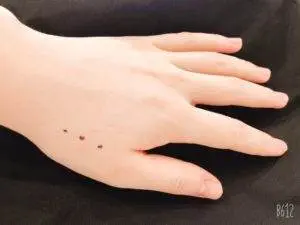
In TCM theory, health depends on the free flow of Qi (life force energy) and blood throughout the body. Pain is caused by blockages that create stagnation, when Qi and blood get stuck. This can happen because of injury, but it can also be caused by what we call external pathogenic factors, such as Wind, Cold, and Dampness. When Cold and Dampness accumulate in the shoulder area, they obstruct the flow of blood, and this blood stagnation causes pain. In Chinese Medicine, we call obstructions due to these external pathogens “Bi Syndromes.” Joint pain–sometimes referred to as arthralgia–is one of the primary symptoms of Bi Syndromes. Thus, according to TCM, shoulder pain would be considered a symptom of a wider problem. We focus on the deeper roots of the disorder, rather than simply trying to get rid of the pain.
An acupuncturist will look closely at the whole picture: other symptoms that may or may not seem to be related, the quality and degree of pain, the specific limitations of movement, when the pain is worse, and what makes it feel better. The TCM practitioner will then make a diagnosis that pinpoints the combination of pathogenic factors that underlies the pain in the shoulder.
TCM differentiation of shoulder pain:
- Wind-Cold – acute shoulder pain that may move around and get worse with cold weather.
- Cold-Damp – shoulder feels heavy and swollen, worse in rainy weather, helped by heating pad
- Damp-Phlegm – shoulder muscles feel sore and heavy, hard to move
- Qi Stagnation – sensation of numbness, shoulder is aggravated by stress and emotions
- Blood Stagnation – chronic, stabbing pain, gets worse at night
Chinese herbs are a key component of TCM treatment for shoulder pain. Specific herbs are used to dispel Wind and Cold, clear Dampness and Phlegm, and promote circulation of blood and Qi.
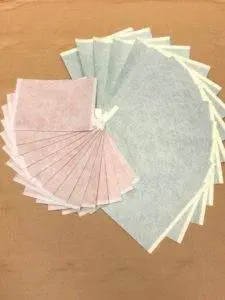
Acupuncture for Frozen Shoulder
In China, we have a nickname for frozen shoulder that translates as “50s shoulder.” This condition occurs most frequently in middle age, and more often in women than in men. Repetitive movements over many years eventually take a toll on the muscles and tendons of the shoulder, and the soft tissues become less resilient to minor injuries.
One of the main problems of a frozen shoulder is that in order to improve the condition, the joints must be moved in ways that will increase flexibility. However, the pain can be too intense, creating a fear of movement that only makes the situation worse.
TCM has very specific acupuncture techniques that are designed to help “thaw” the frozen shoulder. A systematic review of controlled trials utilizing a specific acupoint (ST38) to address shoulder adhesive capsulitis found positive results in clinical efficacy for easing pain and restoring mobility. During an acupuncture session, which may include the addition of electrostimulation, the patient’s pain is reduced to an extent that the practitioner can direct and manipulate the joint with other techniques (acupressure, Tuina or Gua Sha therapeutic massage, and gentle passive movements). In some cases, we may ask a patient to perform active movements of the shoulder while needles are inserted. This technique is called motion style acupuncture (MSAT), and has been shown in one controlled trial to help improve shoulder functionality. These modalities used in combination can help break down scar tissue and increase the range of motion in the shoulder joints.
Best Acupuncture in Los Angeles for Shoulder Pain
Acupuncture is a great modality to help reduce shoulder pain and improve range of motion of the shoulder without negative effects. Dr. Tan and Dr. Cai have been practicing acupuncture and Traditional Chinese Medicine with their unique background and knowledge in both Chinese Medicine and traditional Orthopedics for over 30 years. They will work with you and your other specialists to create a treatment program that will have your shoulder moving freely again.
*This article is for education from the perspective of Traditional Chinese Medicine only. The education provided by this article is not approved by FDA to diagnose, prevent, treat and cure human diseases. It should not stop you from consulting with your physician for your medical conditions. Traditional Chinese Medicine is based on Qi, which is an invisible force that usually cannot be observed by modern science. Because science focuses on testing ideas about the natural world with evidence obtained through observation, these aspects of acupuncture can’t be studied by science. Therefore acupuncture and Chinese herbs are often not supported by double-blind, randomized trials, and they are considered alternative medicine therapies in the United States.
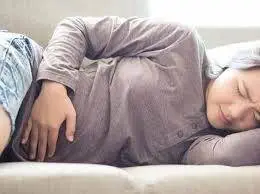
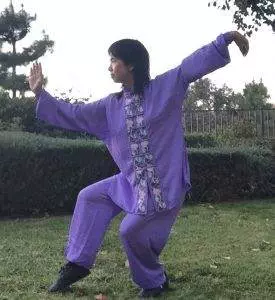
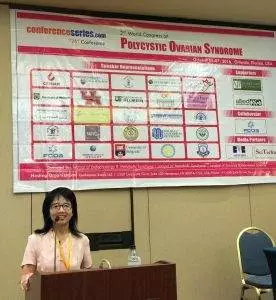
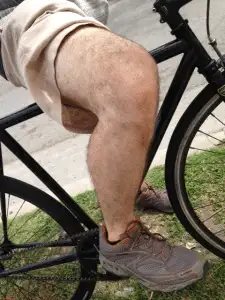 a “second heart” for the body. We rely on the large muscles of the legs to push the blood upwards, completing the “circle” of circulation. So if there is a problem in the leg, it not only affects the knees, but all of the organs.
a “second heart” for the body. We rely on the large muscles of the legs to push the blood upwards, completing the “circle” of circulation. So if there is a problem in the leg, it not only affects the knees, but all of the organs.